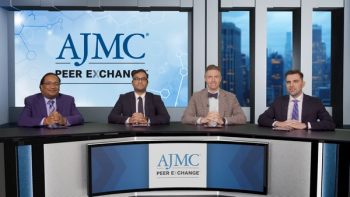
Overview of CLL, MCL, and SLL
Callie Coombs, MD, and Brian Koffman, MD, provide an overview of chronic lymphocytic leukemia, mantle cell lymphoma, and small lymphocytic lymphoma, and explore the key differences between these disease states.
Episodes in this series

Ryan Haumschild, PharmD, MS, MBA: Hello, and welcome to this AJMC® [Peer Exchange] program titled “Bruton Tyrosine Kinase Inhibitors in Leukemia and Lymphoma.” I am Ryan Haumschild, the director of pharmacy services at Emory Healthcare and the Winship Cancer Institute [in Atlanta, Georgia]. Joining me in this discussion are my colleagues Dr Callie Coombs, an associate clinical professor at the University of California Irvine; Dr Roy Beveridge, a senior strategic adviser at Avalere Health [in Louisville, Kentucky]; and Dr Brian Koffman, the executive vice president and chief medical officer at the CLL Society [in Chula Vista, California]. Our panel of experts will provide an overview of the burden of disease in leukemia and lymphoma, discuss the BTK [Bruton tyrosine kinase] inhibitor landscape for these diseases, review payer considerations for BTK inhibitor treatment, and discuss future directions for BTK inhibitors in leukemia and lymphoma. Thank you. Let’s begin.
First, let’s get started with a broad overview of the impact of chronic lymphocytic leukemia [CLL], mantle cell lymphoma [MCL], and small lymphocytic lymphoma [SLL] and describe the clinical burden. Dr Coombs, I’ll turn to you first. Can you give us an overview of these 3 disease states and some of the characteristics that define CLL, SLL, and MCL?
Callie Coombs, MD: I’d argue that these are 2 disease states for the most part. CLL and SLL are by most clinicians considered the same disease. However, they do have different manifestations. CLL is considered the most common leukemia in the Western world—20,000 patients are diagnosed annually in the United States. Small lymphocytic lymphoma, for all intents and purposes, is the same disease with 1 key difference. It doesn’t have a significant leukemic component, which is defined by over 5000 clonal B cells in the peripheral blood. Small lymphocytic lymphoma most typically manifests in patients with lymphadenopathy but without a significant blood compartment.
These are common diseases in the blood cancer world. Mantle cell lymphoma, by contrast, is quite a bit less common. It represents 5% or 6% of non-Hodgkin lymphoma [cases], which is about 4000 annually. Both diseases are predominant in men, more so with mantle cell lymphoma, which is 3 men to every 1 woman. They are very different in their treatment and clinical presentations. However, BTK inhibitors play a role in the therapy of both diseases.
Ryan Haumschild, PharmD, MS, MBA: Dr Koffman, are there any other differences that you’d like to highlight in those clinical diagnoses?
Brian Koffman, MD: The thing I want to emphasize is not so much those differences, which was just covered, but the differences in the way patients present. At the CLL Society, we like to say that if you know 1 patient with CLL, then you know 1 CLL patient, because [the disease] comes in so many different flavors. There are patients who will never need treatment, and there are patients who are in trouble on day 1, who are going to need aggressive therapy. We think you have to understand and look at the patient in front of you in terms of their circumstance, prognostic predictive markers, comorbidities, and age because it’s not 1 size fits all for CLL or SLL.
Ryan Haumschild, PharmD, MS, MBA: That’s really important. As you go through that 1 size fits all, the patient journey is very different. It’s going to be different based on everyone’s experiences. Talk us through that patient journey and how that differs for each patient. What are some of the manifestations of those diseases in patients that make them have different treatment approaches throughout their journey?
Brian Koffman, MD: That’s a great question. As a physician turned patient, I can address some of these things. One of the first things to happen when patients are diagnosed with CLL or SLL is they’re often told, “You’ve got the good cancer.” Patients hate hearing the words good and cancer in the same phrase. From an oncologist’s point of view, compared with other individuals in our office with pancreatic cancer or stage IV ovarian cancer, this is a good cancer. But you can’t ever say that to a patient. You can say you’ve got a cancer that’s slow growing, and that we have some time to deal with this.
The next thing that happens is we’re not going to do anything. We’re going to do some tests, and I’ll see you in 3 months to see how you’re doing. The cognitive dissonance that this presents is wild for the patients. You just told me I have cancer. Often the next thing they say is, “It’s an incurable cancer, and you’re not going to do anything? Are you really a doctor? What’s going on here?” That’s a difficult issue for patients, understanding why you aren’t going to treat them. If you find something on a mammogram, you take care of it immediately. If you have an abnormal Papanicolaou test or you find a polyp on a colonoscopy, you take care of it. You don’t watch and wait. You don’t do active observation. Those are a couple of things early in the course of the disease, this sense that it’s a good cancer. We’re going to actively observe you. You’ve got to hold the patient’s hand through those beginning steps.
Transcript edited for clarity.
Newsletter
Stay ahead of policy, cost, and value—subscribe to AJMC for expert insights at the intersection of clinical care and health economics.







